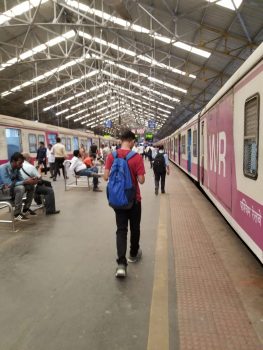Venturing on The Mumbai Suburban Railway Posted by Nitya on Jul 31, 2018 in Hindi Language
Most visitors to India and Mumbai have heard about the packed local trains of the Mumbai Suburban Railway. Few have the courage to venture a ride and those who do so are either exhilarated or scarred … the experience is yours to define.
The swell of passengers will sweep you in and shove you out of the compartment automatically, unless you stand your ground firmly and hang tight to the overhead handles. Ladies-only compartments allow women the option to travel in safety and privacy, while “general” compartments are open to everyone. Off-peak hours are almost non-existent … perhaps an hour in the afternoon when it’s too hot or too late in the day to embark on a trip or errand.
The local train (Mumbai suburban train) is known commonly as “local” लोकल. There are 3 main lines/routes along which the network plies. They are:
1. Central line (CST is the southernmost tip of this line)
2. Western line (Churchgate is the southernmost tip of this line)
3. Harbor line (CST is the southernmost tip of this line)
2. Western line (Churchgate is the southernmost tip of this line)
3. Harbor line (CST is the southernmost tip of this line)
Some common terms and questions related to traveling in Mumbai local trains are below. Note that many sentences include English words which are acceptable and understood in local conversation.
लोकल (local) = local train
फ़ास्ट लोकल /तेज़ लोकल (fast local/taze local) = fast local train that doesn’t stop at every single station along that line.
धीमी/स्लो लोकल (dheemi/slow local)= slow local train that stops at every single station along that line.
12-डब्बा (baara dabba) = 12-car train [The other option is the 8-car train. Positions of the ladies compartment as well as first-class compartments will vary for the 8-car and 12-car train. Hence, knowing this upfront via the overhead announcement will give you time to position yourself at the appropriate spot on the platform.]
यह फ़ास्ट लोकल है या स्लो लोकल?
Yeh fast local hai ya slow local?
Is this a fast local train or slow local train?
Is this a fast local train or slow local train?
यह गाडी CST जायेगी?
Yeh gaadi CST jaayegi?
Will this train go to CST?
[Note: CST is the terminus on the Central and Harbor lines.]
Will this train go to CST?
[Note: CST is the terminus on the Central and Harbor lines.]
यह १२-डब्बा है क्या?
Yeh 12 dabba hai kya?
Is this a 12-car/coach train?
Is this a 12-car/coach train?
Please ज़रा दादर स्टेशन आये तो बताना हाँ?
Please zara Dadar station aaye to batana, haan?
Please let me know when Dadar station arrives, OK?
[Note: Dadar station allows one to change between the Central line and Harbor line.]
Please let me know when Dadar station arrives, OK?
[Note: Dadar station allows one to change between the Central line and Harbor line.]
Western line के लिए किधर change करना पडेगा?
Western line ke liye kidhar change karna padega?
Where do I have to change trains to get on the Western line?
Where do I have to change trains to get on the Western line?
कुर्ला स्टेशन कौनसी side में आएगी?
Kurla station kaunse side mein aayegi?
On which side is the platform for Kurla station?
[Note: Kurla station allows one to change between the Central line and the Harbor line.]
On which side is the platform for Kurla station?
[Note: Kurla station allows one to change between the Central line and the Harbor line.]

Keep learning Hindi with us!
Build vocabulary, practice pronunciation, and more with Transparent Language Online. Available anytime, anywhere, on any device.
Share this:




